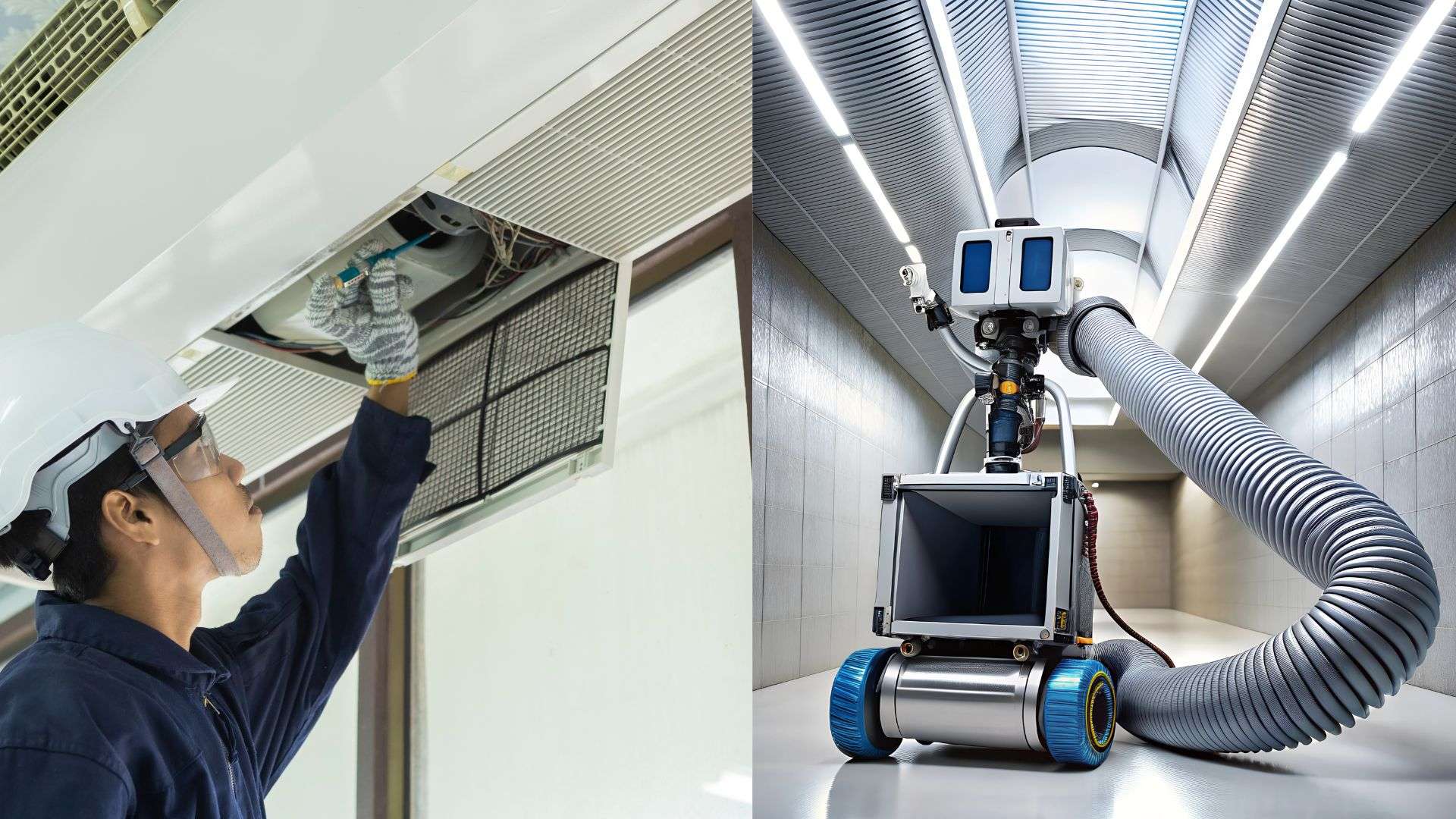
Duct inspection is essential in ensuring cleanliness and efficiency in HVAC systems. Regular inspection ensures the ducts are free from blockages, contamination, and damage that might impair indoor air quality and system performance.
Duct inspection uses two standard methods
Traditional HVAC duct inspection and robotic duct inspection. Although both methods aim to achieve similar objectives-by identifying issues with the ductwork-they differ significantly in their approach, tools employed, and efficiency.
This article explores the differences between these two methods, helping you understand their pros, cons, and applications.
Traditional HVAC Duct Inspection
Traditional inspection involves procedures performed by the technicians manually. Here’s their overview, methods, and features.
Method of Approach
- Technicians physically inspect ducts using tool devices like flashlights, mirrors, or borescopes.
- Sometimes, portions of the ductwork are dismantled to afford them a thorough inspection.
Tools of the Trade
- Essential inspection tools include handheld cameras and mirrors.
- Borescopes or endoscopes are for viewing inaccessible areas.
Accuracy
- It depends on the technician’s skill and whether potential problems are correctly diagnosed.
- Possibility of little cracks, leaks, or contaminants not being detected.
Time & Labor
- It’s implicit; thus, it takes much longer because much manual labour is involved.
- Accessibility problems can cause other instances to require extra long periods.
Safety Issues
- Technicians enter confined spaces, meaning potential safety hazards.
- It is not always feasible in ducts that are tough to access or dangerous conditions.
Robotic Duct Inspection
Robotic duct inspection is an advanced and technically evolved method of inspection of ducts, paving the way for mechanical inspection by using robotics.
Here follows the detailing of the idea and its advantages:
Method
- The robotic inspecting device has high-resolution cameras and sensors and is sent into the duct.
- The robot will navigate the system, providing a live video of the inspection and real-time discovery of issues.
Instruments Used
- Robots with cameras, lights, and sometimes even sensors for air quality measurement or leak detection.
- Remote or autonomous navigation systems let operators control the robot and monitor it.
Accuracy
- It presents a clear, accurate picture of the ducts, showing hairline cracks, leaks, or contamination.
- Creates digitized reports, pictorially supported reports, or videos of the problems.
Time and Labor
- Less tedious as robots can travel the ductwork smoothly.
- Less manual labour is needed. Hence, inspection time and costs are reduced.
Safety and Accessibility
- Gets rid of the need for personnel to enter confined or dangerous spaces.
- Suitable for accessing small ducts that are difficult or inaccessible for human entry.
Key Differences Between Traditional and Robotic Inspection
Aspect | Traditional HVAC Inspection | Robotic Duct Inspection |
Method | Manual inspection with essential tools. | Robotic navigation with advanced cameras. |
Accuracy | Dependent on technician skills; less precise. | High accuracy with detailed visuals. |
Time Efficiency | Time-consuming and labor-intensive. | Faster and more efficient. |
Safety | Risky for technicians in confined spaces. | Eliminates safety concerns. |
Cost | Lower initial cost but higher labor expenses | Higher initial cost but reduced labor costs |
Reporting | Limited to manual observations. | Comprehensive digital reporting. |
The Benefits of Doing Robotic Duct Inspection
High-perfectness: Robots with specialized cameras reveal minute details, able to detect problems accurately.
Quick: The job takes less time, with inspections put in place in a fraction of the time of traditional solutions.
Economy: Although startup costs should be higher, robotic duct inspection reduces the cost of labour.
Safety Lost: No longer are technicians subject to a small confined or hazardous area, thus reducing their risks.
Data-Gathering Insight: Robotic systems put in place reports complete with video evidence for use in making intelligent, well-thought-out choices.
How to Choose a Method of Inspection
Where traditional duct inspection via HVAC and robotic duct inspection differs, include:
Budget: Traditional seems cost-effective initially, but robotic inspection often turns economically favorable in the long run.
Complexity: Robotic inspection prefers complexity or flawed scenarios.
Safety Requirements: In hazardous environments, robotic inspection wins without question.
Conclusion
Traditional and robotic HVAC duct inspections are motivated by the same goal: diagnosing and fixing challenges within the ductwork. Nevertheless, with technological advancement, robotic inspection has become a game-changer regarding accuracy, efficiency, and safety. Businesses and homeowners can significantly benefit from the accuracy of robotic systems and perform optimal maintenance to maximize air quality.
Here at GreenWorks AC, we provide robotic duct inspection services with light-touch results. Robotic inspection ensures that your HVAC system runs perfectly while being thoroughly cleaned and meticulously inspected. For more information on our advanced duct cleaning and inspection services, check out our website GreenWorks AC.
The innovation of robotic duct inspection means that you are investing in a solution as agile as the quality, safety, and cost-effectiveness of production line demands.
